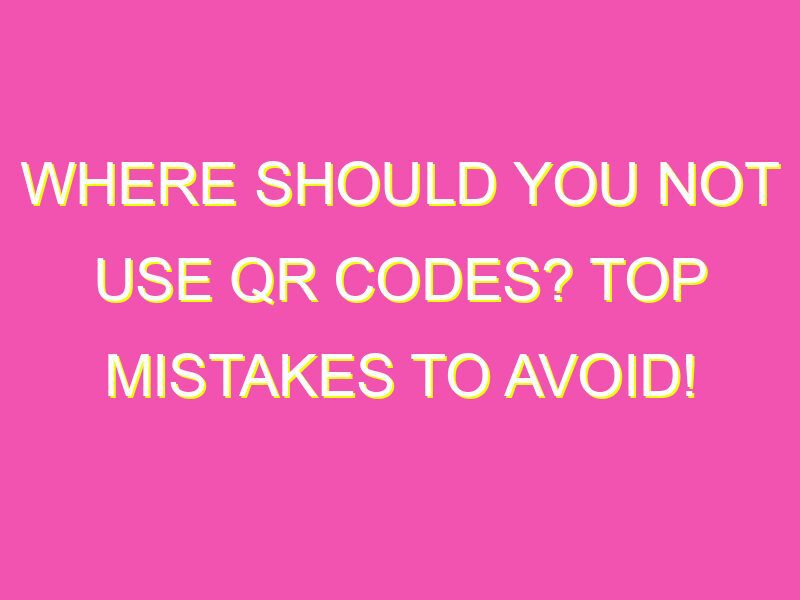Want to use QR codes for payments? Think again. While they may appear convenient, there are risks involved. Here are some instances where you should steer clear of using QR codes:
While QR codes can be convenient, be mindful of potential risks like fraud and scams. Protect yourself and your personal information by avoiding these situations.
Introduction to the potential risks of QR codes
QR codes have become increasingly popular in recent years, appearing on everything from billboards to product packaging. While they can be a convenient way to access information quickly, they also come with potential risks. QR codes can be used maliciously by hackers and cybercriminals to steal personal information, so it’s important for users to be cautious when scanning them. In this article, we will discuss the risks and best practices for using QR codes safely.
The dangers of using QR codes for payment
One of the more concerning uses of QR codes is for payment. While it may seem like a convenient way to pay for products or services, it also comes with a higher risk of fraud. Scammers could tamper with QR codes to redirect payments to a different account or steal sensitive financial information from a user’s device.
It’s important to remember that there are a variety of alternative payment methods that are less prone to fraud than QR codes. Credit cards or payment apps like PayPal or Venmo are more secure and have the added benefit of being traceable in the event of fraud. While it may be tempting to use QR codes to pay for a bill, users should exercise caution when doing so.
Alternative payment methods to consider
When it comes to payment methods, it’s important to choose one that is both convenient and secure. Here are a few alternative payment options to consider:
- Credit cards: Credit cards come with fraud protection and are widely accepted by retailers.
- Payment apps: Payment apps like PayPal or Venmo allow for secure transactions without needing to share sensitive financial information.
- Mobile wallets: Mobile wallets like Apple Pay or Google Wallet use biometric authentication to ensure secure transactions.
While each of these alternatives has its own set of pros and cons, they are generally considered to be more secure and less prone to fraud than QR codes.
Don’t scan QR codes from unknown sources
QR codes can be used maliciously to redirect users to dangerous websites or download malware onto a device. For this reason, it’s important to only scan QR codes from trusted sources. If a QR code appears suspicious, it’s best to avoid scanning it altogether.
Users should also be wary of unexpected QR codes, such as those received via email or text message. These could be a phishing attempt designed to steal personal information or infect a device with malware.
The potential for QR codes to be used maliciously
QR codes have the potential to be used maliciously in a variety of ways. Hackers and cybercriminals can use them to steal personal information or spread malware.
One common tactic is to place malicious QR codes on physical objects, such as posters or billboards, where they can be easily scanned by unsuspecting users. These codes may redirect to phishing sites or download malware onto a device. As such, it’s important to be cautious when scanning codes from physical objects, especially those that appear suspicious.
Can’t judge a QR code by its appearance
QR codes can appear harmless in the sense that the naked eye isn’t able to detect the code’s intentions. However, hackers can manipulate QR codes in various ways to trick users into scanning them. For example, they could overlay a legitimate code with a fake code that leads to a malicious site, or print a malicious code on top of a legitimate code.
For this reason, it’s important to always scan QR codes with caution. If something feels off about the code or the source it’s coming from, it’s best to avoid it altogether.
Best practices for staying safe while using QR codes
Here are a few tips to keep in mind when using QR codes:
- Only scan codes from trusted sources: Avoid scanning codes from unknown or suspicious sources, as they could be malicious.
- Consider alternative payment methods: While QR codes may seem like a convenient way to pay for products or services, they also come with a higher risk of fraud. Consider using a credit card or payment app instead.
- Do not share sensitive information: Avoid sharing sensitive financial or personal information when scanning QR codes.
- Use anti-malware software: Protect your device from malware by using anti-malware software.
By following these best practices, users can reduce the risk of falling victim to QR code related scams or fraud. Remember, when in doubt, it’s always better to err on the side of caution.





